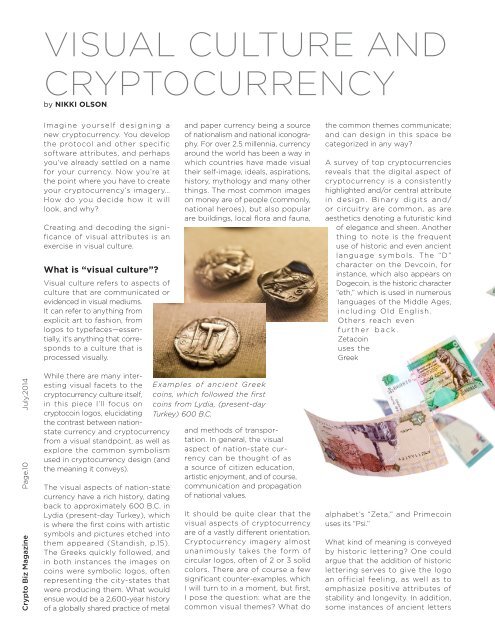Crypto Biz Magazine—July, 2014/Issue.02
Digital Currencies & Crypto Innovations—We observe and explore all aspects of the crypto world, including mining, financial trading, exchanges, development and business.
Digital Currencies & Crypto Innovations—We observe and explore all aspects of the crypto world, including mining, financial trading, exchanges, development and business.
You also want an ePaper? Increase the reach of your titles
YUMPU automatically turns print PDFs into web optimized ePapers that Google loves.
VISUAL CULTURE AND<br />
CRYPTOCURRENCY<br />
by NIKKI OLSON<br />
Imagine yourself designing a<br />
new cryptocurrency. You develop<br />
the protocol and other specific<br />
software attributes, and perhaps<br />
you’ve already settled on a name<br />
for your currency. Now you’re at<br />
the point where you have to create<br />
your cryptocurrency’s imagery…<br />
How do you decide how it will<br />
look, and why?<br />
Creating and decoding the significance<br />
of visual attributes is an<br />
exercise in visual culture.<br />
What is “visual culture”?<br />
Visual culture refers to aspects of<br />
culture that are communicated or<br />
evidenced in visual mediums.<br />
It can refer to anything from<br />
explicit art to fashion, from<br />
logos to typefaces—essentially,<br />
it’s anything that corresponds<br />
to a culture that is<br />
processed visually.<br />
and paper currency being a source<br />
of nationalism and national iconography.<br />
For over 2.5 millennia, currency<br />
around the world has been a way in<br />
which countries have made visual<br />
their self-image, ideals, aspirations,<br />
history, mythology and many other<br />
things. The most common images<br />
on money are of people (commonly,<br />
national heroes), but also popular<br />
are buildings, local flora and fauna,<br />
the common themes communicate;<br />
and can design in this space be<br />
categorized in any way?<br />
A survey of top crypto currencies<br />
reveals that the digital aspect of<br />
cryptocurrency is a consistently<br />
highlighted and/or central attribute<br />
in design. Binary digits and/<br />
or circuitry are common, as are<br />
aesthetics denoting a futuristic kind<br />
of elegance and sheen. Another<br />
thing to note is the frequent<br />
use of historic and even ancient<br />
language symbols. The “D”<br />
character on the Devcoin, for<br />
instance, which also appears on<br />
Dogecoin, is the historic character<br />
“eth,” which is used in numerous<br />
languages of the Middle Ages,<br />
including Old English.<br />
Others reach even<br />
further back.<br />
Zetacoin<br />
uses the<br />
Greek<br />
Page.10 July.<strong>2014</strong><br />
<strong>Crypto</strong> <strong>Biz</strong> Magazine<br />
While there are many interesting<br />
visual facets to the<br />
cryptocurrency culture itself,<br />
in this piece I’ll focus on<br />
cryptocoin logos, elucidating<br />
the contrast between nationstate<br />
currency and cryptocurrency<br />
from a visual standpoint, as well as<br />
explore the common symbolism<br />
used in cryptocurrency design (and<br />
the meaning it conveys).<br />
The visual aspects of nation-state<br />
currency have a rich history, dating<br />
back to approximately 600 B.C. in<br />
Lydia (present-day Turkey), which<br />
is where the first coins with artistic<br />
symbols and pictures etched into<br />
them appeared (Standish, p.15).<br />
The Greeks quickly followed, and<br />
in both instances the images on<br />
coins were symbolic logos, often<br />
representing the city-states that<br />
were producing them. What would<br />
ensue would be a 2,600-year history<br />
of a globally shared practice of met al<br />
Examples of ancient Greek<br />
coins, which followed the first<br />
coins from Lydia, (present-day<br />
Turkey) 600 B.C.<br />
and methods of transportation.<br />
In general, the visual<br />
aspect of nation-state currency<br />
can be thought of as<br />
a source of citizen education,<br />
artistic enjoyment, and of course,<br />
communication and propagation<br />
of national values.<br />
It should be quite clear that the<br />
visual aspects of cryptocurrency<br />
are of a vastly different orientation.<br />
<strong>Crypto</strong>currency imagery almost<br />
unanimously takes the form of<br />
circular logos, often of 2 or 3 solid<br />
colors. There are of course a few<br />
significant counter-examples, which<br />
I will turn to in a moment, but first,<br />
I pose the question: what are the<br />
common visual themes? What do<br />
alphabet’s “Zeta,” and Primecoin<br />
uses its “Psi.”<br />
What kind of meaning is conveyed<br />
by historic lettering? One could<br />
argue that the addition of historic<br />
lettering serves to give the logo<br />
an official feeling, as well as to<br />
emphasize positive attributes of<br />
stability and longevity. In addition,<br />
some instances of ancient letters


